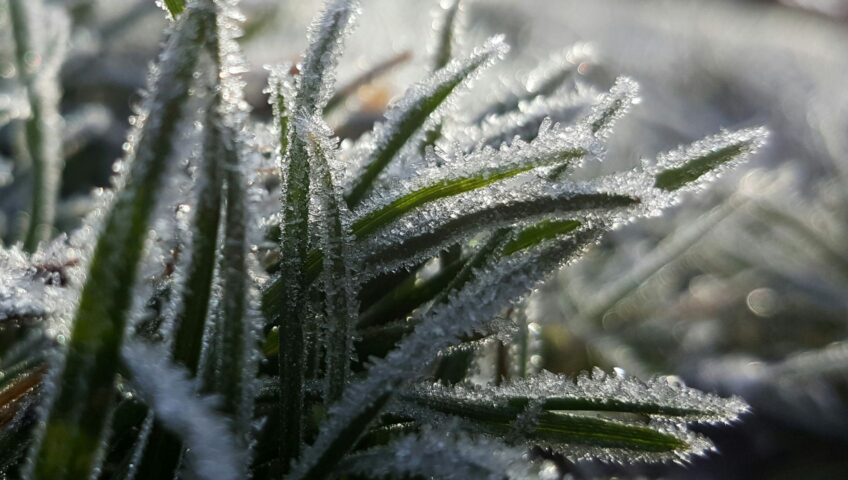A common mistake many homeowners make is neglecting protective lawn maintenance before winter. The colder months bring dropping temperatures, snow accumulation, ice, and frost — all these factors can wreak havoc on an ill-prepared turf.
Entering spring with a perfectly preserved lawn is much more appealing than the alternative. Why waste time mitigating winter damage when you could be planting fresh flowers, enjoying the sunshine, and installing beautiful hardscape features? Taking a few proactive steps can save you a major headache once the snow thaws.
Here are our seven tips for easy protective winter lawn care.
1. Aerate
Overly compacted soil can suffocate grass, preventing vital nutrients and water from seeping into the soil. Proper aeration is critical in the fall, as you want to leave ample space for your lawn to breathe and grow deeper roots before going dormant. You also want to ensure the soil receives plenty of nutrients to last throughout the season (almost like a bear before hibernation).
Below is a step-by-step guide to aerating your lawn before winter:
- Apply 1 inch of water to your lawn the day before you plan to aerate the soil
- For lightly compacted soil, run over the lawn once with an aerator
- For very compacted soil, repeat the process perpendicular to the first
- Leave removed plugs on the lawn (they will deteriorate and fertilize the ground over time)
- Finish the process by watering the lawn well
- Continuing watering your lawn every few days for a couple of weeks
2. Fertilize
Like aeration, fertilizing your lawn pre-frost optimizes nutrient absorption and retention. For example, a winter-specific blend provides grass with essential nitrogen and potassium to promote resiliency. Come spring, the nutrients stored in the roots promote the development of a lush, green, and vibrant turf. Moreover, fertilizer reduces the risk of pests, weeds, and plant diseases once temperatures rise.
3. Keep Grass Short
Mowing is important when prepping your lawn for winter. Tall grass opens the door to pesky snow mold and winter fungal diseases. A fuzzy lawn is also incredibly attractive to burrowing rodents. The last thing you want to see after the springtime thaw is a turf riddled with holes, nests, and tunnels.
Additionally, shorter grass is naturally more resistant to winter precipitation like snow and heavy ice. Essentially, accumulation is less of an issue when lawn blades are kept well-trimmed. The less space for debris and heavy materials to collect, the more space grass has to breathe.
4. Remove Debris & Leaves
Excess leaves, twigs, and other organic debris can suffocate your grass during the winter. These materials can also become saturated with snow, creating conditions ripe for mold and disease development. Even patio furniture and firepits shouldn’t sit directly on the grass or you risk soil becoming too compacted. In the end, properly clearing unnecessary materials sets your lawn up for a smooth, easy transition into the winter.
5. Limit Foot Traffic
Frozen grass is brittle and liable to damage. Even healthy, robust lawns can fall victim to excess traffic when exposed to prolonged freezing temperatures. To minimize any potential harm, avoid walking, driving, or sitting on your lawn during the winter.
6. Be Mindful of Salt Damage
Ice melt and salt are essential for keeping driveways and paths safe for walking. However, their chemical components can hurt your lawn and plants. Salt can reduce moisture levels in the soil, meaning grass loses valuable nutrients stored in roots. Chloride ions in ice melt can also interrupt chlorophyll production, leading to brown spots beneath the snow.
However, being mindful of where, when, and how you apply these solutions can limit possible damage. Use sparingly when possible and make an effort to limit direct contact between chemicals and grass. Alternatively, you can use all-natural blends to eliminate the likelihood of negative impacts.
7. Use Plant Covers
Winter covers can be especially beneficial for sensitive, delicate plants. These wraps shield your precious shrubs from the harsh elements, helping ensure root, structure, and aesthetic integrity stay intact.
Invest in quality burlap, polypropylene, or fleece jackets that offer the most coverage and insulation. You want to retain heat as much as possible, so always make sure covers are tightly wrapped and secured.
In Conclusion
Winterizing your lawn doesn’t require as much time and effort as you may assume. Just a handful of easy tasks can make a massive difference in the overall health of your lawn. Having an extra hand can further streamline the process and facilitate a successful fall-to-winter transition.
Over my years in business, I’ve helped thousands of homeowners like you preserve their beautiful lawns and gardens throughout harsh Ohio winters. For me, seeing customers enjoy their property in the springtime is the ultimate reward.
Whether you’re looking for help with a few maintenance issues or an entire winterization project, my team and I are ready to help see you through the end of the year and into the next. Contact us today for more information or browse our website for our latest educational blogs. I look forward to hearing from you!

